 Planetary nebulae, supernovae, quasars, and gamma-ray bursts
Planetary nebulae, supernovae, quasars, and gamma-ray bursts



What we have seen inside the centre of the galactic nucleus seem to have much resemblances with what one may observe all over the cosmos in different dimensions - starting from the scale of the stars to the clusters and superclusters of galaxies. As I have said before, the process of growth of structures and their decays follow the similar mechanism, whether they are tiny stars taking births inside gaseous nebulae, or dying while showing the blaze of the planetary nebulae of hundreds of light years, or clusters of galaxies forming and decaying in the scale of hundreds of millions of light years.
In this chapter I shall mainly concentrate on the births and deaths of the stars,. A star is so tiny that one can pack billions of them inside a small galaxy. However small they may appear, compared to a galaxy, the stars show the same method of formation and decay as in the cases of galaxies. So by studying the fate of the stars one should be able to get a glimpse about the fate of the galaxies, the clusters, the superlusters and so on.
The stars are our closest neighbors and it is easy for us to study the phenomena of cosmic birth and death in this neighborhood. The path of the Milky Way, traced by the galactic arms, which we see in the sky, is the best place to observe many spectacular events, which are caused by the ejections and formations, as well as deaths and destructions. The best areas to study are around the hot spots of the arms, from where ejections occur. In our galaxy the main ejection mouth lies in the Sagittarius arm between Ophiuchus and Scorpius. Sagittarius lies in between them. Here one can see many births and deaths of stars and star clusters. These births and deaths result in the ejections and outflow. During the process of the formation, the gas clouds whirl and form spiral structures, causing ejections of clumps from the spiral arms. These clumps fly as clouds before new stars may take births in those clouds. When the stars, which form in the clouds, start burning they illumine the clouds and create colorful veils around the new born stars. The evolutions of these structures from spiral to elliptical shapes give rise to the evolution of star clusters, from the open and loose form to the tight and compact nature.
The births of the clusters of stars create magnificent scenes in the sky when viewed through the telescopes. Such births could be initiated by collisions of clouds - at places where jets, emerging from the centre, may strike the spiral arms and create
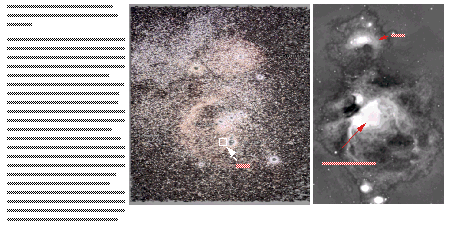
hotspots. The births of structures follow the hierarchical build up generating spirals inside spirals inside spirals and so on. During the evolution of the structure, as the cosmic objects grow by forming hierarchically ascending shells, smaller structures are shed from the outer shells. From these smaller clouds, which separate from the larger one and move outwards, smaller clusters of stars may develop. These smaller clumps in turn, as they evolve, may shed even smaller clumps from their outer shells. From these even smaller nebulous clouds single, or multiple stars may take births. The ejected structures move in an environment where other structures, broken away from bigger chunks, are also moving. These ejected clumps may merge with each other, and form bigger objects. Thus splitting, merging, splitting and merging again and again go on in different hierarchical scales inside the clouds, where cosmic objects of different sizes are born. These interactions of the smaller and the larger structures at different scales form a network of structures, which I have called the cosmic design. During the formation of the stars some parts of the outer shells may separate from the turbulent inner core, and fly as nebulous halo in the surrounding interstellar medium. Those shell structures which separate from a larger chunk of clouds, and remain engaged in the process of forming bigger agglomeration of stars in the spiral forms, will possess several stars in their veils, while a small chunk broken from a smaller cloud will appear as a cradle of birth of a single star, surrounded by a nebulous cloud.
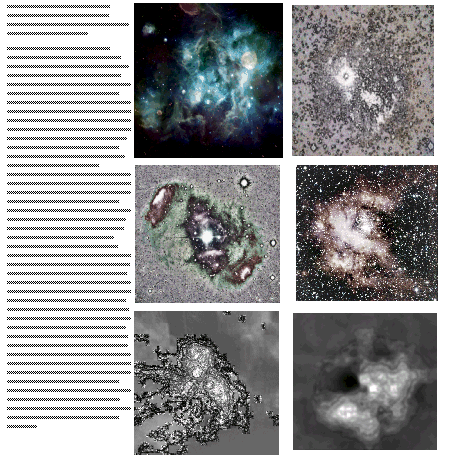
In the conventional theory of star formation, the condensation of gas cloud creates the collapse of the clouds as the result of gravitational attraction. The collapse heats up the core, which becomes the sites of star births. After the star is born the stellar wind creates a cavity around the new born star and expel the remaining clouds, which are not accreted by the star. After this process of birth from a collapsed cloud, the stars evolve according to the nuclear reactions taking place inside the core. The stars burn as long the hydrogen fuel is not used up. When all hydrogen are burnt out, it collapses again and ignite the helium burning in the core and turn into extremely hot helium stars. This heat creates a nebula hundreds of times larger in size around the star and then passes into a dying phase. It is believed that most stars in the sky will one day face such gradual death at the end of their life cycles. However, some stars will face more dramatic ends. These stars are the larger ones, where the fuel burning may occur very fast causing a very quick evolution. As a price of such a fast growth, they end in explosive deaths, which create fiery scenes. They have been called supernovae. These supernovae bursts are believed to create shocks in the surrounding gas clouds, and set the process of condensation of the clouds around it, where new stars may be born.
The star formation model, in the new theory, differs much from this conventional view. First, the clouds do not condensate due to gravitational collapse initiated by he shocks of supernovae. The stars are born inside cloudlets which are expelled from the shells of larger structures, where bigger stars or stellar clusters take shapes as filamentary knots. As the knots tighten while they evolve through the turbulent medium, cloudlets are hurled outward. As the outflow strikes the surrounding medium, it experiences shock compression and the seeds of stellar structures are created. Thus smaller and smaller structures, may form while triggered by the ejections from larger structures. The birth of a structure at any particular scale have consequences in generating a series of births of smaller structures, which in turn set the conditions of birth of even smaller structures in the next scale. It is the shock, caused by the birth of a structure at a large scale, which creates the conditions of births of the smaller objects. It is not the gravitational attraction which is the driving force behind the star births. The dynamics of stellar births are driven primarily by magneto-hydrodynamic turbulent flows, which animate every corners of the universe. I shall come back to this discussion in the next chapter.
Before I start with the story of the deaths of the stars, which are known to create the planetary nebulae and supernovae, I shall discuss briefly about the role of the merging of the stars in the story of structure formation. As the clouds split and form star clusters, and individual stars, they also merge and form larger stars. However, the merging of stars do not occur in the environment like the one where our sun is situated, because the stars are far apart in such an environment. Our nearest stars are several light years apart from one another. The interactions among the stars can occur in denser environments, where the stars move very close to each other. This may happen in the cores of large and evolved stellar clusters, like globular clusters, where thousands, or millions of stars may be packed in a small volume. Here the cannibalism of stars, as we see at the centre of our own galaxy, may be observed. Such cannibalism will give rise to x-ray bursts and flux variabilities.
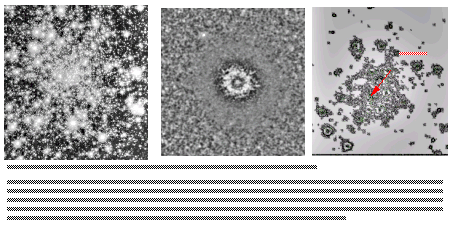
The region, where the cosmic structures have started to form, give rise to cascade of structure formation of smaller objects from larger chunks. The breakdown into smaller and smaller pieces continue deep inside the centre, which is surrounded by outer shells, which in turn may eventually break apart from the main structure as the structure evolves. The evolution of structures, generate shells after shells, which are hierarchically stacked inward towards the core. As a result, the structure, which may have started in a loose spiral phase, may gradually evolve into an elliptical form, like in the case of the galaxies. More deeper one penetrates the core, denser become the material, which form the shells. More one moves towards the core the metal abundance also increase, because the denser and hotter environments act as furnaces where heavy elements are generated by nuclear fusions. After reaching the evolved elliptical phase, which are normally called the globular clusters, the star clusters should disintegrate like all other cosmic objects. Such a cluster will show disruptions and break down of ring-like structures, which may have formed around the core. The disintegrated parts of such rings will form smaller globules creating a halo around the central core. In the centre one may discover very dense stars, like neutron stars, which may show the characteristics of pulsars.
The stellar clusters, which I have described above, have sizes of several tens of light years. The cluster M22, which is about 60 light years across, contains many millions of stars. Such structures are too big compared to the dimensions of stars we normally see in the sky. The sizes of the biggest stars we observe, like some red giant stars, do not exceed the size of the orbits of Earth around the sun. Most numerous stars in a galaxy are probably the red-dwarf stars, which are much smaller than the size the sun. There are stars which are even smaller - some could be only a few times larger than the size of the planet Jupiter. They are known as brown dwarfs.
The smaller stars are often very dim and therefore difficult to study. The bigger stars, which shine brightly in the sky, have been the objects of observations since the old time. In the past, there have been also observations of sudden appearance of stars, which outshine all other stars in the sky for a short period, and then fade away. A few of them are recorded in the history: The earliest such records are by the Chinese in 352 BC. During the last one thousand years human beings have observed half a dozen of such new stars: Among them the one, observed in 1054, shone as bright as the full moon for a period of 23 days, before it faded away. It could be seen during the day for about a month, and was visible in the evening sky for about a year. The Chinese called it the "Guest Star". After it faded away its existence was forgotten for more than 650 years before the invention of the telescopes, which detected a nebula in the same place. In 1774 it was noted in the Messier Catalogue of Nebulae and Star Clusters. In 1939 the first observation of the expansion of the nebula was made. Since then the interests in studying the nebula, called Crab Nebula, increased rapidly. By 1960s it was observed to emit strongly in radio and x-rays. The real excitement came when one noted rapid radio pulses (30 per second) coming from the heart of the nebula. The object, emitting the pulses was called a pulsar. It was soon theorized that it must be a very small and dense star made of neutron matter, which was rotating fast and swinging a radio jet inside the core of the nebula. Like the lights from a light house, this radio jet was generating the pulses observed by the Earthly detectors.
The mystery of the "Guest Star", once observed by the Chinese 950 years ago, is now believed to be understood: The blazing star was nothing but the end of the life cycle of a star at that position. A star had exploded and created the optical flare. The debris of the explosion are still visible and they are strong sources of radio and x-ray emissions. Such cataclysmic explosions of stars are called supernovae. Since then, during the last 950 years, human beings have observed three supernovae in our galaxy: One in 1572, known as Tycho's supernova; one in 1604, called Kepler's supernova, and the last one in 1987, named SN 1987A. There is another star, which exploded and created a supernova in the years between 1667-1680, whose optical flares have not been intense and gone unnoticed as new star by the sky gazer of that time. It has been discovered because of its intense radio emission. It is now known as SN1680, or Cassiopeia A. It is the strongest radio source outside the solar system. As the supernovae are very bright emitters in radio and x-rays, during the last few years these supernovae have been intensely studied in different wavelengths with a hope to be able to understand the mechanism of the deaths of stars.
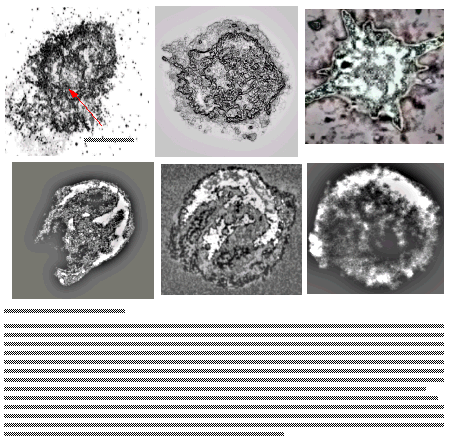
When one analyses the spectra, one discovers that the supernovae are of different types: Some arise from the debacle of stars which contain lots of hydrogen and helium, and some occur in stars where hydrogen and helium are absent. This has led to the speculation that the first type, which are known as Type II supernovae, must be occurring in younger stars, which have not yet burnt all their hydrogen fuel. They explode because of the gravitational collapse of the core. The other type, known as Type I supernovae, have burnt the lighter elements and therefore they must be older stars, which have gone through the process of stellar evolution from young blue star to white dwarf. Such a star may form a binary with a star with swollen boundaries, like red giants and stars which devour material from their companions. This cannibalism increases the mass of the star. According to the theory of star formation there is a limit up to which the stellar mass may grow. Once it exceeds that limit, known as Chandrashekhar limit, it is destined to explode. As it explodes, the companion star, which it has been devouring, is hurled away and disappears from the view.
These theories of star formations are based on the gravitational theory based on general theory of relativity. The type II supernovae are associated with jets from the centre and do not indicate the phenomenon of core collapse. Instead, they show typical structures observed in many planetary nebulae, where the knots, binding the shells, break and fly away as jets, while releasing the outer shells to expand. In the case of the Crab, this breakdown has occurred deeper within the core, while the outer shells still remain bound. The jet, which has emerged from the centre, has disrupted the symmetric building of shells lying on the opposite sides, and thus forced its way through the stellar gas and dust, while pushing them away from the centre. In the case of Cassiopeia A the jet is not so forceful, and disruptive as in the case of Crab supernova. The same is true for the SN 1987A, where the jets ply through the inner structure.
The case for Type I supernova is different. In the new theory they appear as the ejecta from the dying stars. They could be the knot structures, which break away from the stellar system in two opposite directions. Once freed from the knots, the stellar shells expand, which one may see in many SNRs. These ejected knots can be found far away from

the remnant where the dual shells move away from each other and expand as if caused by an explosion. These remnants may also show characteristics of the Type I supernovae.
The Type I supernovae have become an interesting subject in cosmology these days. In the conventional view they occur as the results of interactions between stars in a binary system, and considered as the standard candles of similar intrinsic brightness wherever they may take place. Combined with this assumption about their intrinsic brightness, the Type I are considered to be spherical explosions. On the basis of these two ideas the cosmologists have found a new method of gauging the distances of the external galaxies, where type I supernovae may occur. By knowing the distance by this way one can calculate the velocities of the galaxies. Thus the cosmologists have recently found out that the universe must be accelerating.
As I have shown, the type I supernovae are not all of unique shapes: They show evolutionary differences. As they evolve they turn from oblong bubbles to spherical shapes, and may not always show a spherical distribution of their intrinsic brightnesses. Moreover, all supernovae taking place, in external galaxies, are not of Type I. The supernovae occurring in spirals and barred spirals are often of Type II. Only those occurring in the elliptical galaxies belong to the Type I category.
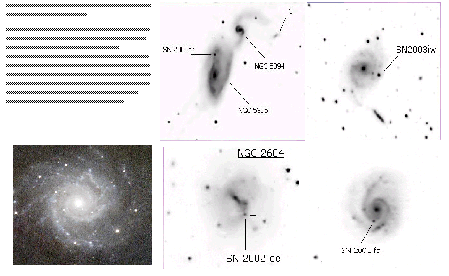
All supernovae occurring in barred spiral or spiral galaxies are also not only of type II. They can be type I too. However, the type I supernovae in such galaxies occur in very different environment, than the type II. They are seen to occur normally outside the spiral arms and close to the centre. They appear as bubbles, which could be objects ejected from the central bulge.

In elliptical galaxies, where there are little hydrogen left to form the usual spiral arms, the galaxies may start breaking down by blowing jets. These ejections are observed as radio jets in the galaxies. Often old stellar objects are seen to be flying around the cores of such galaxies, forming haloes of old stars. The type Ia supernovae are seen to occur mostly in these halo stars, which are ejected from the core. The majority of the Type Ia supernovae in elliptical galaxies are observed along the directions of the jets, or close to the jets. It might well be possible that the jets emerging from the centre could initiate a process which cause the flares in the stellar system, that one may observe as the Type Ia supernovae. It is not evident that the Type Ia supernovae, occurring in spiral and barred spirals, would bear the same intrinsic intensities as those which occur in the ellipticals. Moreover, they may not be spherical in illumination, as conventionally assumed.

One may wonder if the Type Ia supernova are exploding stars or just bubbles blown from the core, where the flares observed are triggered by the jets blowing from the centre. On the basis of what I have discussed it appears that the understanding of the subject of the supernovae may require a revision.
Supernovae have also been found to be associated with the gamma-ray bursts, which the gamma-ray satellites have started detecting on the average of one everyday since the time of their launching in the beginning of 1990s. The sources of these sudden flares in gamma-rays, occurring for a time varying from milliseconds to seconds, remained a mystery until the optical counterparts were observed. These optical counterparts indicated that the origin of the gamma-ray burst sources were in galaxies outside the Milky Way. The regions where these gamma-ray bursts occur are often associated with the regions dominated by high red-shift galaxies, where stars are taking births. However, the origin of such enormous gamma-explosions remained unclear until the discovery that the Gamma-ray burst GRB980425, which occurred on 25 April 1998 (naming of a GRB indicates the date of observation). It was actually associated with a supernova taking place in a nearby galaxy. The supernova associated with this gamma-ray burst, turned out to be a Type Ic. This supernova was more powerful than the usual ones and were believed to be the results of the collapse of hypermassive stars.
I do not share this interpretation and instead believe that these flares are not associated with core collapse.The gamma-ray flares are generated by the ejecta from the centres of a star forming region. In the case of the GRB 980425, it occurs at the centre of a star-forming region existing beyond the spiral arm of a young star-forming galaxy, which is under evolution. The bursts occurred at the centre of a stellar cluster under formation. An ejecta can be seen to be moving from the position of the gamma-ray burst. The optical flares occur when this ejecta from the centre strikes the dense shells, where the stars are being formed. Like the birth of star cluster, such ejecta may also occur while a large single star is born. The ejecta may partially, or totally disrupt the double shell structures, common to all cosmic bodies. When one observes this disruption in a star it is interpreted as supernova of Type II. The rapid speed of formation destabilize the usual dynamics of the hierarchical shell formations by the mechanism of ejections from the centre. In the GRB 980425, the ejecta has caused minor disruption and not brought a catastrophic change in its structure. In more catastrophic events, the ejecta will disrupt the mechanism by which the cosmic structures take their shapes and evolve.

The gamma-ray burst GRB030329, which occurred on 29 March 2003, is an example of a burst involving catastrophic changes. It is one of the strongest gamma-ray bursts ever recorded, and lasted for an unusually long time. Normally the optical flares, seen in GRBs, which follow shortly after such burst, do not last for more than a few hours. In the case of GRB030329 one could follow the optical flares for many days. The spectral properties of the emission showed a striking similarity with the GRB980425 burst, indicating its closeness to a type Ic supernova. It had been argued that this burst is a rosette stone example of the collapse of a hypermassive star, which will generate a black-hole and a disk around the black-hole, which in turn will cause ejections of jets. When these jets slam into the dense material, where the collapse has taken place, they generate the high-energy and optical flares. It may not be the case. The gamma-ray burst, like GRB030329 seems to undergo dramatic changes of phase. It begins with the breakdown at the centre, which generates ejecta. These ejecta disrupts, and brings catastrophic changes to the structure which surrounds the central knot. Within a few hours the entire structure undergoes violent changes of shapes, while the ejecta ply through the central region. After a few days, when the ejecta has penetrated the outer shells, the structure settles into a more known phase where the core is surrounded by shells. These shells then expand, as in the case of type II supernovae.

Such ejections have been observed in several other cases where the optical counterparts of the strong bursts have been observed. The interpretation that these ejections are spherical fireballs, created by the explosions generated by a hypernova, has gained popularity among the scientists studying gamma-ray bursts. However, the present analysis indicates that instead they are created by the ejections of structures. The GRB030329 occurred in an environment where the host object is accompanied by similar objects in the surrounding. These objects appear to be in highly active phase of ejections of smaller structures, while filling the space around them with many ejecta of dwarf objects.

What are these highly active cosmic objects where the strong gamma-ray bursts occur? The strong bursts seem to occur at high redshifts and are often seen to take place in a surrounding populated by dwarf blue galaxies, which are interpreted as star forming galaxies. The strongest bursts possibly occur in compact structures of elliptical shapes, rather than in spiral ones. The weak bursts, in turn, could be associated with spiral galaxies, as in the case of GRB980425, and could be a phenomenon primarily associated with low-redshift galaxies. So there seems to exist characteristic differences between the group of strong gamma-bursts and the weak ones.

It appears that the host galaxies, where the strongest gamma-ray bursts occur, bear very close similarities with the objects which are known as blazars and BL-Lacertae objects. These BL Lacs and Blazars are a class of quasi-stellar objects (quasars), which show very high variabilities in their optical, infrared and radio emissions in particular. They are often seen to appear in a loose cluster of galaxies, and normally elliptical in shapes.

The discovery of the BL Lacs came with the observation of a variable object outside the Milky Way galaxy. Until 1970 only two such variable extragalactic objects were known. They showed not only variable emissions in optical wavelengths, but also in radio, and were bright radio sources. With it came the discovery of the quasi-stellar objects, or quasars, which were star-like objects whose optical spectrum were highly redshifted. The redshifts of these objects meant that they were moving away from us at tremendous speeds. Using the cosmological model of the big-bang theory, these high redshift objects were interpreted as objects which were very distant from us. Thus they were believed to be objects which had formed long before the beginning of the large galaxies in the universe, which appear in lower redshifts. Some of the quasars had so high redshifts that they were considered as the objects which bear the clues of the beginning of the birth of the universe. Quasars shine in almost all wavelengths, though most efficiently in the x-rays. They have spectral properties much different than the normal stars. Belief, which rose from the cosmological model, that these star-looking objects were outpouring emissions from an enormously distant realm, led the scientists to conclude that quasars were immensely bright star-like cosmic objects. The highest redshifts measured of the quasars led them to conclude that these objects were shinning from distances of billions of lights years from us. Based on this understanding quasars became the brightest objects known in the universe. Then the speculations began about what could be the dynamics behind these star-like objects of such immense illumination. Black-holes came to the limelight. They were believed to be causing the outpouring, while the material were flowing into the bellies of the black-monsters. Soon BL Lac objects were included in the category of the quasars.
Some of these quasars showed extreme variabilities in their emissions in all wavelengths. They were called blazars. The variabilities of the blazars were explained as the effect of the special orientation of the quasars in the sky relative to the direction of observation. The enormous emissions from the quasars were explained as being caused by the swirling of plasma around the black-hole and then falling towards the object which possessed a mass billions times more than the mass of our sun. According to the popular models of the quasars, two jets should appear perpendicular to the disk, in which the material swirl around the black-hole and most of the emissions are carried away along the cones forming the jets. The blazars were explained as those quasars whose jets face directly towards us.
With the launching of the satellites, carrying the gamma-ray detectors in the 1990s, the number of the members of the blazar family had started growing. These objects were found to be immensely bright in their gamma-ray output. The blazars became the dominant gamma-ray sources outside the Milky Way. The variabilities in the gamma-ray output spanned from seconds to years, and remained as an enigma to explain. Several hundred of blazars have already been catalogued by now.
In the following pages I shall present a new interpretation about the nature of the quasars, the BL Lacs and the blazars.


In contradiction to the present scientific understanding, the quasars and the blazars are nothing but ejections from seyfert galaxies, which Halton Arp have been expounding for the last 30 years. His views have not received popularity because it contradicts the big-bang cosmology, which has dominated scientific view about the universe.
Those stories about the immensely blazing stars of billions of solar masses harbouring black-holes and appearing before the appearance of the galaxies are products of a theory, and the unrestraint fantasies of those who possess unfailing faith in the big-bang cosmology. Halton Arp has newly shown how a high redshift quasar are embedded near the core of low redshift seyfert galaxies, demonstrating without any doubt that the quasars are not those mysterious objects which one envisioned by looking through the crystal ball of the big-bang.

The quasars are not of one type. Moreover, all of them are not high redshift ejected objects too. The nuclei of galaxies showing low redshifts also harbour quasars varying in sizes. In more evolved galaxies, like the ellipticals, these quasars are the largest. Spirals may possess mini quasars at their cores, like our own galaxy. As I have shown before, the centres of galaxies may eject huge massive structures, which contain mostly heavy elements, and no hydrogen. The quasars themselves may eject structures from their own cores, which may appear as very high-redshift objects.The quasars of different redshifts are phenomena which appear due to the cascading breakup of evolved galactic structures, which I have discussed earlier.
